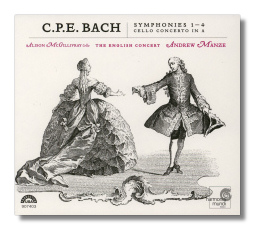
The Internet's Premier Classical Music Source
Related Links
- C.P.E. Bach Reviews
- Latest Reviews
- More Reviews
-
By Composer
-
Collections
DVD & Blu-ray
Books
Concert Reviews
Articles/Interviews
Software
Audio
Search Amazon
Recommended Links
Site News
 CD Review
CD Review
Carl Philipp Emmanuel Bach

Hamburg Symphonies
- Concerto for Cello #3 in A Major, Wq. 172/H 439
- Symphony #1 in D Major, Wq. 183/H 663
- Symphony #2 in E Flat Major, Wq. 183/H 664
- Symphony #3 in F Major, Wq. 183/H 665
- Symphony #4 in G Major, Wq. 183/H 666
Alison McGillivray, cello
The English Concert/Andrew Manze
Harmonia Mundi HMU907403
Also released on Hybrid Multichannel SACD HMU807403
Amazon
- UK
- Germany
- Canada
- France
- Japan
- ArkivMusic
- CD Universe
Almost the first thing that strikes one about C.P.E. Bach's four 'Orchester-Sinfonien', Wq 183, is their variety – of melodic subject matter, of pace, of scoring and of mood. The first thing that strikes one about the playing of The English Concert under Andrew Manze is its grace. C.P.E. Bach made over a dozen experiments with the symphony form. These are the latest, written in 1775. They are far closer to the fast-slow-fast obbligato symphonies of Italian masters like Vivaldi, Sammartini and Galuppi. Indeed the sonata form in Bach's first symphony's first movement is probably nothing other than co-incidence. So it's not surprising that agility, a function of the Italian manner, should inform the playing on this excellent disc. And it's here in very good measure indeed.
Each of the symphonies' movements has something special… a plangent or sprightly melodic line, something ear-catching in the instrumentation, a surprising color in the palette of sounds (which some listeners may feel has been recorded a tiny bit flatly) or phrasing redolent of Mozart, Telemann, Hadyn. The English Concert and Andrew Manze have obviously been at pains to make the most of these characteristics without dissecting the music and leaving it lifeless; though the recording never lacks technical brilliance for an instant.
At the same time their playing respects and re-inforces the architecture of each symphony as an expression in its own right. The way the halting rhythms of #3 for example are almost caressed, and themes tossed from section to section, keeps the listener attentive, which makes the experience all the more satisfying. It's plain that Bach had fun composing these short, lucid works. Manze and his players have realized that and made it their place to communicate the fun to us – though without either self-conscious quippishness. It's also plain from the playing of Manze and company that, while one movement must follow another and unfold in linear fashion, the light yet firm touch with which each is expounded bespeaks a deeper understanding of Bach's overall purpose. The way in which the pauses, rallentandos and accelerandos are savored in the fast movements of the first and second symphonies is ample evidence of this firm grasp of the works, performing editions of which were prepared by Manze for this recording.
The A-major cello concerto Wq. 172 is placed between Symphonies 2 and 3 on the disc. At 20 minutes and twice as long as each of the symphonies, it was composed three years or so after his father's death in 1750 during the highly un-fulfilling time when Carl Philipp Emmanuel was in the service of the unappreciative Frederick the Great of Prussia. It survives in three versions – for flute (surely in deference to Frederick, whose favorite instrument that was), harpsichord (presumably the best way for Bach to have played it himself) and for cello, which is perhaps better suited to the mature and somewhat daring emotional limits that the piece continually nudges.
Alison McGillivray's playing is superb. Her rapport with The English Concert is a delight for listeners to lock into; the resulting empathy – particularly with the sometimes sinuous tempi in the concerto's largo – is ideal. The cello sound is noticeably 'woody'; maybe the solo instrument is just a touch forward, giving at times more of a continuo effect than that of a concerto. The sonorities are beautiful, fresh and even languorous in places – again at the end of the central largo, for example. This makes the pace of the surrounding movements all the more enjoyably snappier.
Manze and his musicians have a clear winner here. Perhaps the CD booklet could have contained just a little more on this elegant music. As an example of poised, paced and perfectly articulated period performances of memorable music from the German high baroque they are extremely satisfying. There is enough carefully-considered interpretative style in the 63 minutes contained here to leave room for others to continue to present their alternatives, but for sheer insight, finesse and beauty, they will be hard to beat and can be wholeheartedly recommended.
Copyright © 2007, Mark Sealey




















